Effect of Carbon Black on Rutting and Fatigue Performance of Asphalt
Abstract
1. Introduction
2. Materials and Methods
2.1. Materials
2.2. Preparation of CB Modified Asphalt
2.3. Test Methods
2.3.1. Basic Properties Test
2.3.2. Performance Grading Test
2.3.3. Multiple Stress Creep Recovery (MSCR) Test
2.3.4. Linear Amplitude Sweep (LAS) Test
2.3.5. Aging Procedures
3. Results and Discussion
3.1. Penetration, Softening Point and Ductility
3.2. Rutting Resistance
3.3. Fatigue Resistance
3.4. Aging Performance
4. Conclusions
Author Contributions
Funding
Institutional Review Board Statement
Informed Consent Statement
Data Availability Statement
Conflicts of Interest
References
- Meng, G.; Tan, Y.; Wang, L.; Hou, Y. A state-of-the-art review on interfacial behavior between asphalt binder and mineral aggregate. Front. Struct. Civ. Eng. 2018, 12, 248–259. [Google Scholar]
- Wang, R.; Xiong, Y.; Yue, M.; Hao, M.; Yue, J. Investigating the effectiveness of carbon nanomaterials on asphalt binders from hot storage stability, thermodynamics, and mechanism perspectives. J. Clean. Prod. 2020, 276, 124180. [Google Scholar] [CrossRef]
- Zhou, Z.; Gu, X.; Dong, Q.; Ni, F.; Jiang, Y. Rutting and fatigue cracking performance of SBS-RAP blended binders with a rejuvenator. Constr. Build. Mater. 2019, 203, 294–303. [Google Scholar] [CrossRef]
- Tong, J.; Ma, T.; Shen, K.; Zhang, H.; Wu, S. A Criterion of Asphalt Pavement Rutting Based on the Thermal-Visco-Elastic-Plastic Model. Int. J. Pavement Eng. 2020, 21, 1–11. [Google Scholar] [CrossRef]
- Wang, S.; Huang, W. Investigation of aging behavior of terminal blend rubberized asphalt with SBS polymer. Constr. Build. Mater. 2021, 267, 120870. [Google Scholar] [CrossRef]
- Li, Y.; Cheng, P.; Siddig, E.A.A.; Han, C. Investigation on thermal aging stability of crosslinked styrene butadiene rubber modified asphalt binder. Road Mater. Pavement Des. 2020, 21, 1902–1917. [Google Scholar] [CrossRef]
- Ma, T.; Wang, H.; He, L.; Zhao, Y.; Huang, X.; Chen, J. Property Characterization of Asphalt Binders and Mixtures Modified by Different Crumb Rubbers. J. Mater. Civ. Eng. 2017, 29, 4017036. [Google Scholar] [CrossRef]
- Luo, H.; Leng, H.; Ding, H.; Xu, J.; Lin, H.; Ai, C.; Qiu, Y. Low-temperature cracking resistance, fatigue performance and emission reduction of a novel silica gel warm mix asphalt binderz. Constr. Build. Mater. 2020, 231, 117118. [Google Scholar] [CrossRef]
- Casado-Barrasa, R.; Lastra-González, P.; Indacoechea-Vega, I.; Castro-Fresno, D. Assessment of CB modified binder in a sustainable asphalt concrete mixture. Constr. Build. Mater. 2019, 211, 363–370. [Google Scholar] [CrossRef]
- Yang, Q.; Li, X.; Zhang, L.; Qian, Y.; Qi, Y.; Kouhestani, H.S.; Shi, X.; Gui, X.; Wang, D.; Zhong, J. Performance evaluation of asphalt with a homogeneous dispersion of carbon nanotubes. Carbon 2020, 158, 465–471. [Google Scholar] [CrossRef]
- Cong, P.; Chen, S.; Yu, J. Investigation of the properties of epoxy resin-modified asphalt mixtures for application to orthotropic bridge decks. J. Appl. Polym. Sci. 2011, 121, 2310–2316. [Google Scholar] [CrossRef]
- Masson, J. Brief Review of the Chemistry of Polyphosphoric Acid (PPA) and Bitumen. Energy Fuel 2008, 22, 2637–2640. [Google Scholar] [CrossRef]
- Tasdemir, Y. High Temperature Properties of Wax Modified Binders and Asphalt Mixtures. Constr. Build. Mater. 2009, 23, 3220–3224. [Google Scholar] [CrossRef]
- Ding, X.; Chen, L.; Ma, T.; Ma, H.; Gu, L.; Chen, T.; Ma, Y. Laboratory Investigation of the Recycled Asphalt Concrete with Stable Crumb Rubber Asphalt Binder. Constr. Build. Mater. 2019, 203, 552–557. [Google Scholar] [CrossRef]
- Zhu, J.; Ma, T.; Fan, J.; Fang, Z.; Chen, T.; Zhou, Y. Experimental Study of High Modulus Asphalt Mixture Containing Reclaimed Asphalt Pavement. J. Clean. Prod. 2020, 263, 121447. [Google Scholar] [CrossRef]
- Chen, T.; Ma, T.; Huang, X.; Ma, S.; Tang, F.; Wu, S. Microstructure of Synthetic Composite Interfaces and Verification of Mixing Order in Cold-Recycled Asphalt Emulsion Mixture. J. Clean. Prod. 2020, 263, 121467. [Google Scholar] [CrossRef]
- Zhu, J.; Ma, T.; Chen, H.; Li, T.; Fu, J. Mechanical properties of high-modulus asphalt concrete containing recycled asphalt pavement: A parametric study. J. Mater. Civ. Eng. 2021, 33, 04021056. [Google Scholar] [CrossRef]
- García-Morales, M.; Partal, P.; Navarro, F.J.; Martínez-Boza, F.; Gallegos, C. Linear Viscoelasticity of Recycled EVA-Modified Bitumens. Energy Fuel 2004, 18, 357–364. [Google Scholar] [CrossRef]
- Salas, M.Á.; Pérez-Acebo, H.; Calderón, V.; Gonzalo-Orden, H. Bitumen Modified with Recycled Polyurethane Foam for Employment in Hot Mix Asphalt. Ing. Investig. 2018, 38, 60–66. [Google Scholar] [CrossRef]
- Salas, M.Á.; Pérez-Acebo, H. Introduction of recycled polyurethane foam in mastic asphalt. Gradevinar 2018, 70, 403–412. [Google Scholar]
- Hınıslıoğlu, S.; Ağar, E. Use of Waste High Density Polyethylene as Bitumen Modifier in Asphalt Concrete Mix. Mater. Lett. 2004, 58, 267–271. [Google Scholar] [CrossRef]
- Alliotti, A.G. Carbon black—Its nature and possible effects on the characteristics of bituminous road binders. Proc. Aust. Road Res. Board 1962, 1, 912–917. [Google Scholar]
- Geckil, T.; Ahmedzade, P.; Alatas, T. Effect of CB on the High and Low Temperature Properties of Asphalt. Int. J. Civ. Eng. 2018, 16, 207–218. [Google Scholar] [CrossRef]
- Li, C.; Fan, Z.; Wu, S.; Li, Y.; Gan, Y.; Zhang, A. Effect of CB Nanoparticles from the Pyrolysis of Discarded Tires on the Performance of Asphalt and its Mixtures. Appl. Sci. 2018, 8, 624. [Google Scholar] [CrossRef]
- Wen, S.; Chung, D.D.L. Effects of carbon black on the thermal, mechanical and electrical properties of pitch-matrix composites. Carbon 2004, 42, 2393–2397. [Google Scholar] [CrossRef]
- Jahanbakhsh, H.; Karimi, M.M.; Jahangiri, B.; Nejad, F.M. Induction heating and healing of carbon black modified asphalt concrete under microwave radiation. Constr. Build. Mater. 2018, 174, 656–666. [Google Scholar] [CrossRef]
- Feng, Z.; Rao, W.; Chen, C.; Tian, B.; Li, X.; Li, P.; Guo, Q. Performance evaluation of asphalt modified with pyrolysis carbon black made from waste tyres. Constr. Build. Mater. 2016, 111, 495–501. [Google Scholar] [CrossRef]
- Li, C.; Ning, F.; Li, Y. Effect of carbon black on the dynamic moduli of asphalt mixtures and its master curves. Front. Struct. Civ. Eng. 2019, 13, 918–925. [Google Scholar] [CrossRef]
- ASTM. Standard Test Method for Ductility of Asphalt Materials; ASTM D113-17: West Conshohocken, PA, USA, 2017. [Google Scholar]
- ASTM. Standard Test Method for Penetration of Bituminous Materials; ASTM D5/D5M-20: West Conshohocken, PA, USA, 2020. [Google Scholar]
- ASTM. Standard Test Method for Softening Point of Bitumen (Ring-and-Ball Apparatus); ASTM D36/D36M-14: West Conshohocken, PA, USA, 2020. [Google Scholar]
- AASHTO. Standard Specification for Performance Graded Asphalt Binder; M320-16: Washington, DC, USA, 2016. [Google Scholar]
- Liu, H.; Zeiada, W.; Al-Khateeb, G.G.; Shanableh, A.; Samarai, M. Use of the multiple stress creep recovery (MSCR) test to characterize the rutting potential of asphalt binders: A literature review. Constr. Build. Mater. 2021, 269, 121320. [Google Scholar] [CrossRef]
- ASTM. Standard Test Method for Multiple Stress Creep and Recovery (MSCR) of Asphalt Binder Using a Dynamic Shear Rheometer; ASTM D7405-20: West Conshohocken, PA, USA, 2020. [Google Scholar]
- Chen, H.; Zhang, Y.; Bahia, H.U. The role of binders in mixture cracking resistance measured by ideal-CT test. Int. J. Fatigue 2021, 142, 105947. [Google Scholar] [CrossRef]
- AASHTO. Standard Method of Test for Estimating Fatigue Resistance of Asphalt Binders Using the Linear Amplitude Scanning; AASHTO TP 101-12: Washington, DC, USA, 2018. [Google Scholar]
- ASTM. Standard Test Method for Effect of Heat and Air on Asphaltic Materials (Thin-Film Oven Test); ASTM D1754: West Conshohocken, PA, USA, 2014. [Google Scholar]
- ASTM. Standard Practice for Accelerated Aging of Asphalt Binder Using a Pressurized Aging Vessel (PAV); ASTM D6521–18: West Conshohocken, PA, USA, 2018. [Google Scholar]
- Darmstadt, H.; Chaala, A.; Roy, C.; Kaliaguine, S. SIMS and ESCA Characterization of Bitumen Reinforced with Pyrolytic Carbon Black. Fuel 1996, 75, 125–132. [Google Scholar] [CrossRef]
- Yamaguchi, K.; Sasaki, I.; Meiarashi, S. Mechanism of Asphalt Binder Aging by Ultraviolet Irradiation and Aging Resistance by Adding Carbon Black. J. Jpn. Pet. Inst. 2004, 47, 266–273. [Google Scholar] [CrossRef]
- D’Angelo, J.A. The Relationship of the MSCR Test to Rutting. Road Mater. Pavement Des. 2009, 10, 61–80. [Google Scholar] [CrossRef]
- Rafi, J.; Kamal, M.A.; Ahmad, N.; Hafeez, M.; Haq, M.F.U.; Asif, S.A.; Shabbir, F.; Zaidi, S.B.A. Performance Evaluation of Carbon Black Nano-Particle Reinforced Asphalt Mixture. Appl. Sci. 2018, 8, 1114. [Google Scholar] [CrossRef]
- Omairey, E.L.; Zhang, Y.; Gu, F.; Ma, T.; Hu, P.; Luo, R. Rheological and fatigue characterisation of asphalt modified by anti-ageing compounds. Constr. Build. Mater. 2020, 265, 120307. [Google Scholar] [CrossRef]
- Chen, H.; Zhang, Y.; Bahia, H.U. Estimating asphalt binder fatigue at multiple temperatures using a simplified pseudo-strain energy analysis approach in the LAS test. Constr. Build. Mater. 2021, 266, 120911. [Google Scholar] [CrossRef]

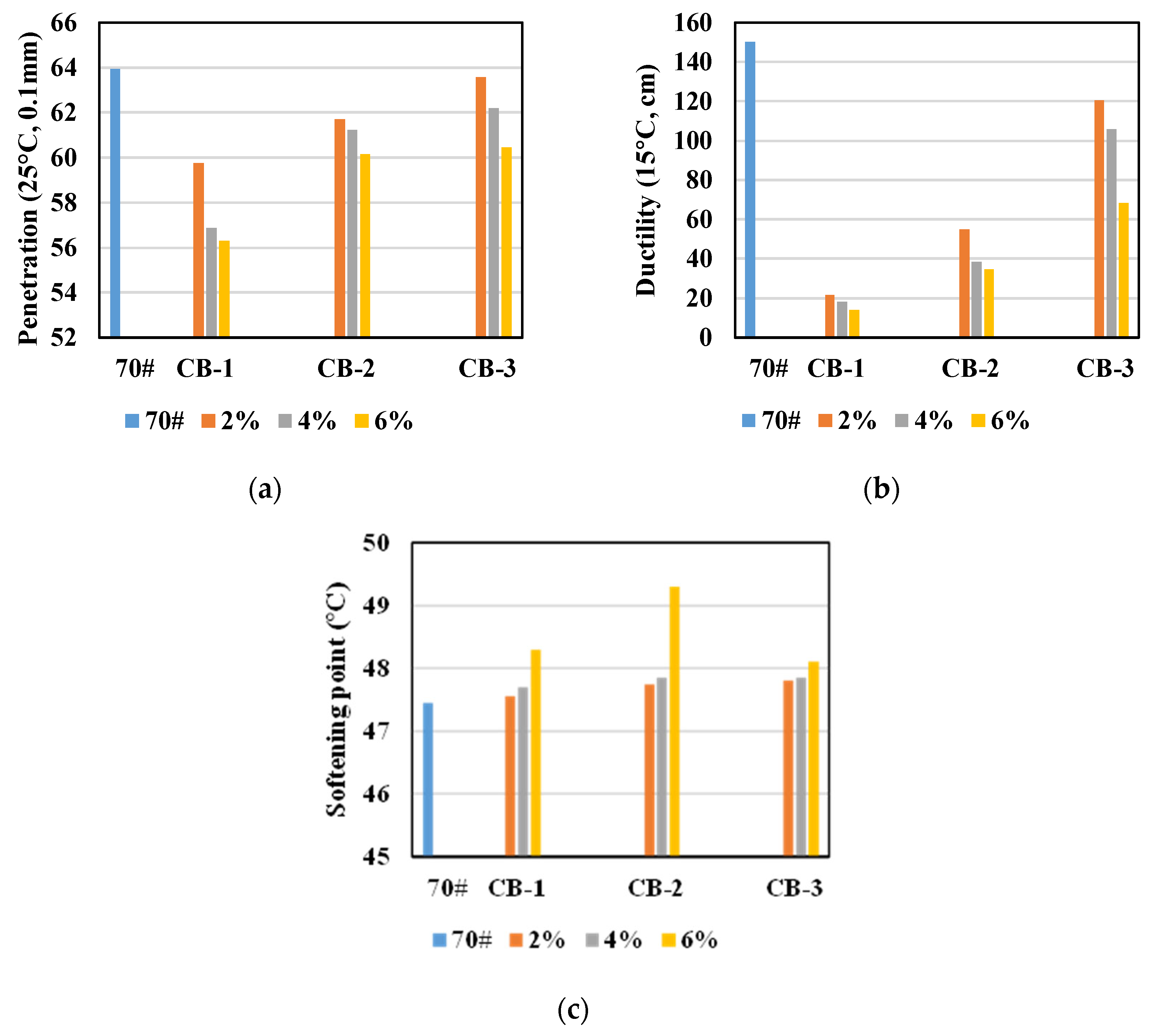

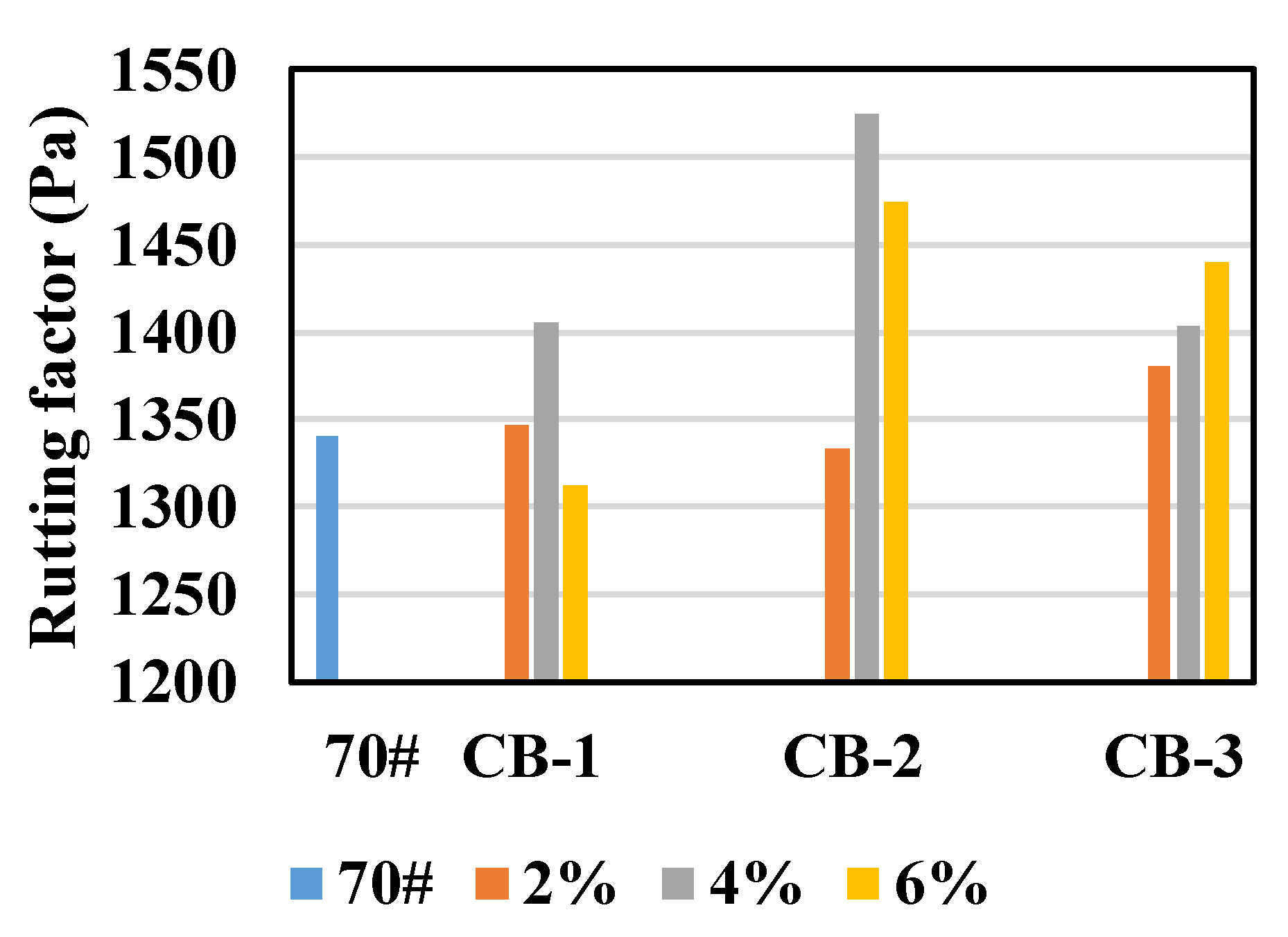
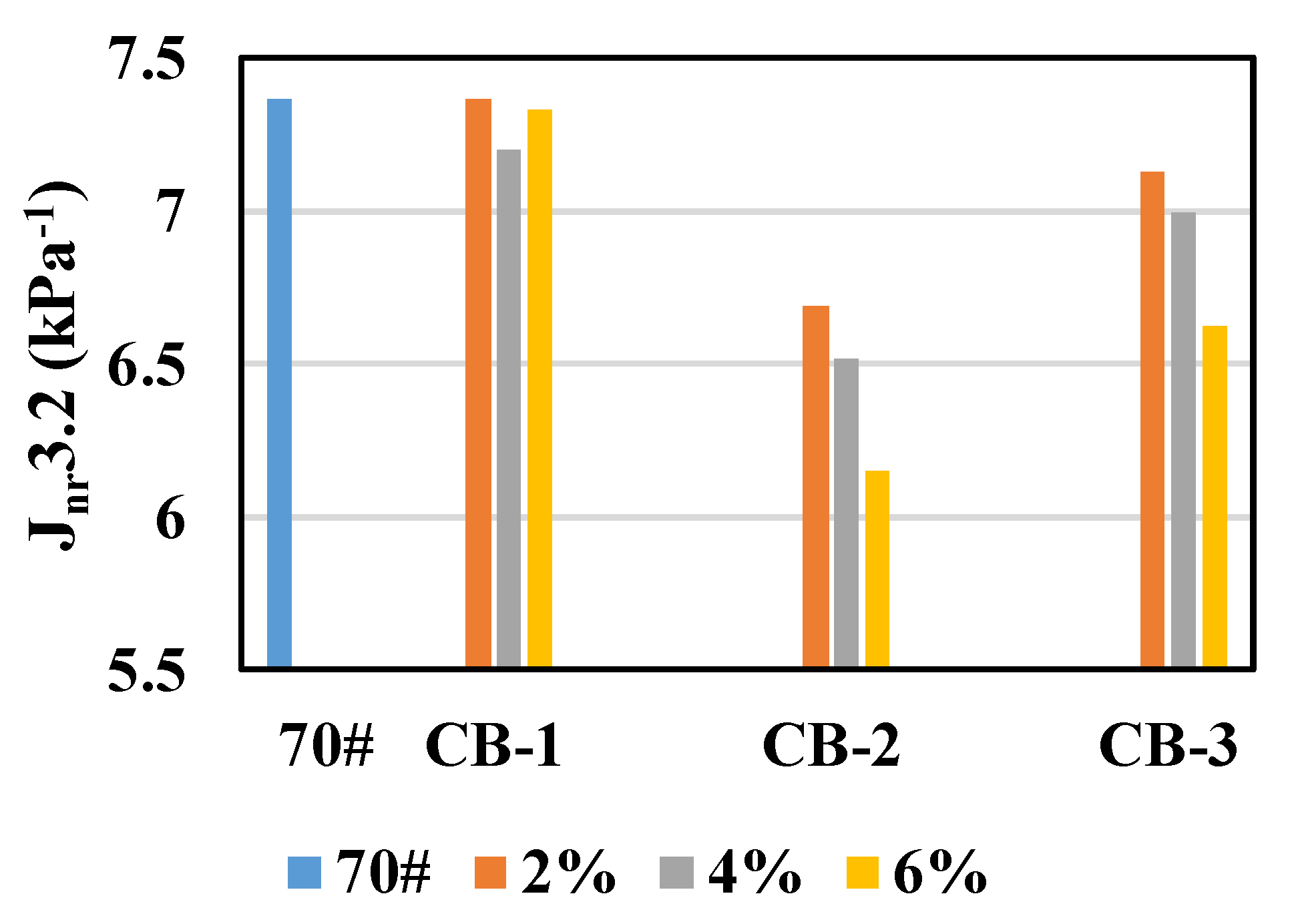
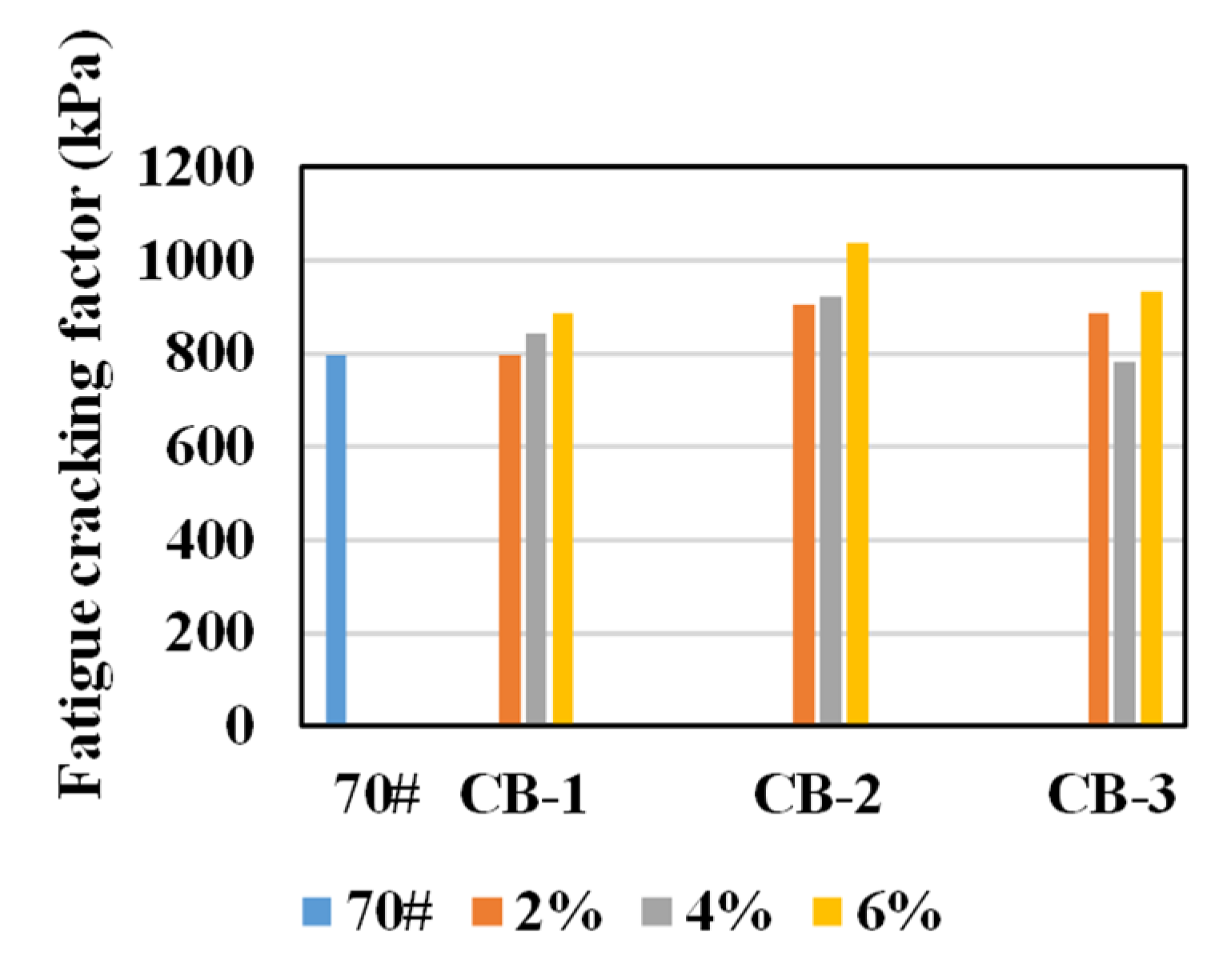
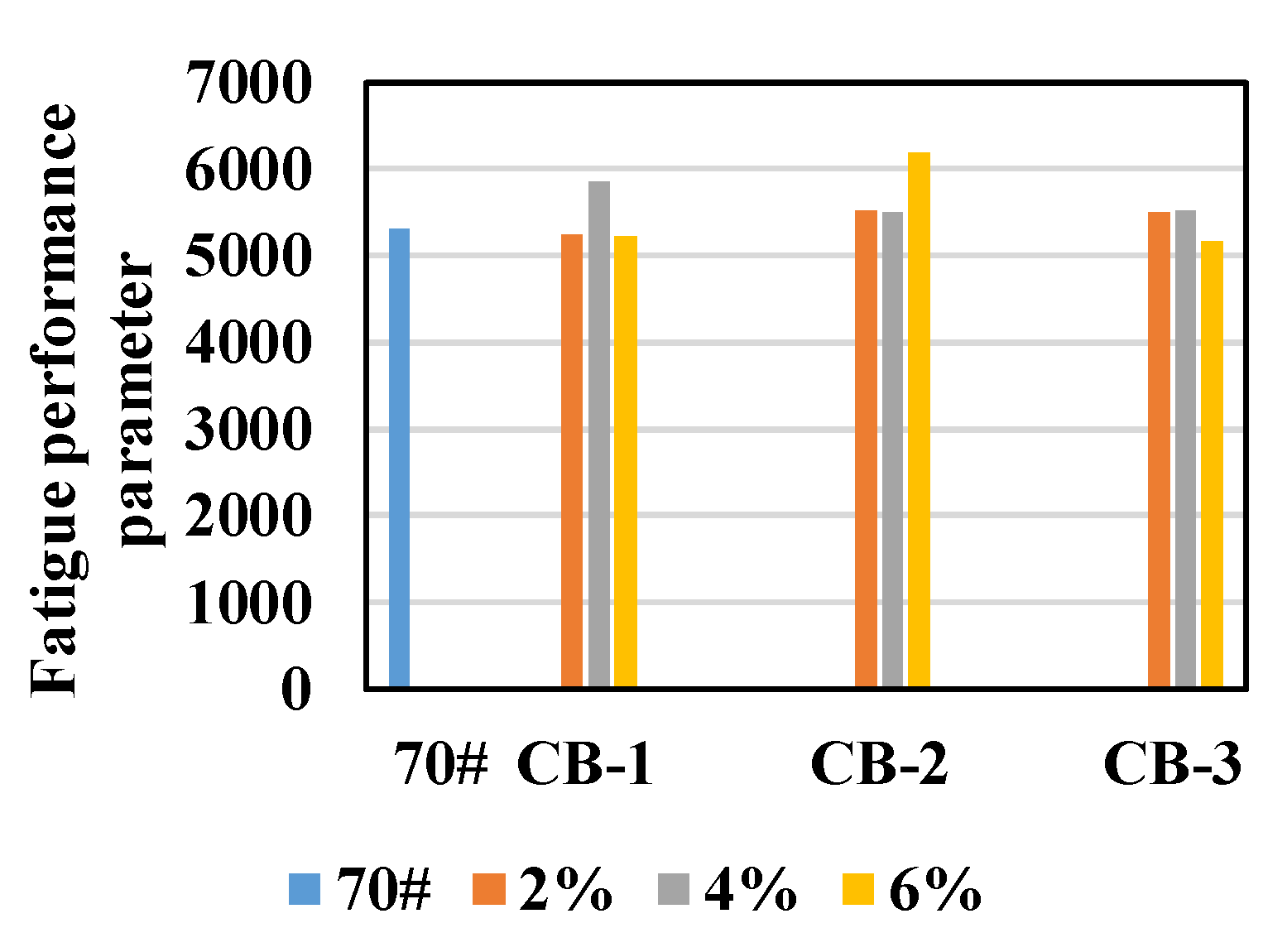

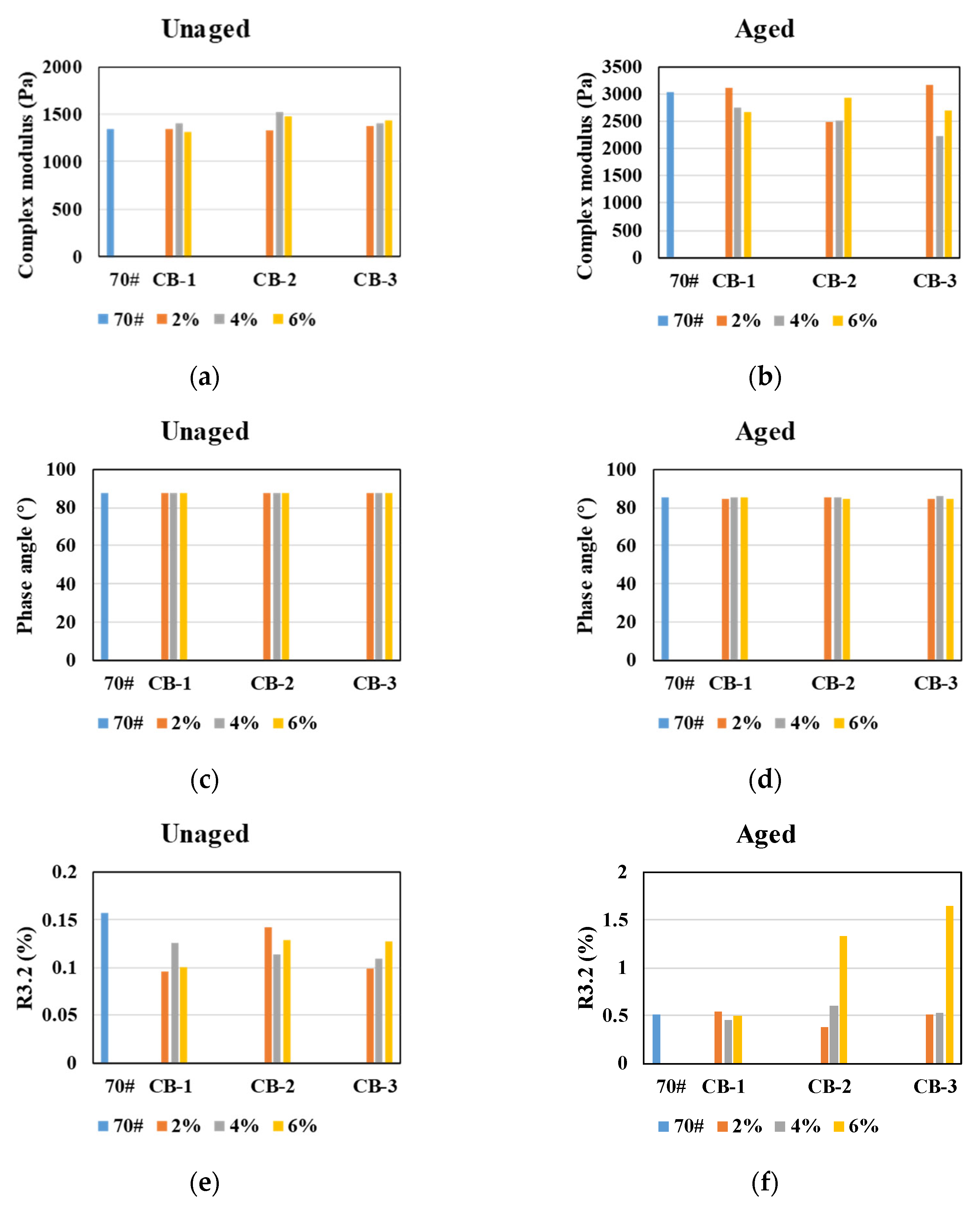
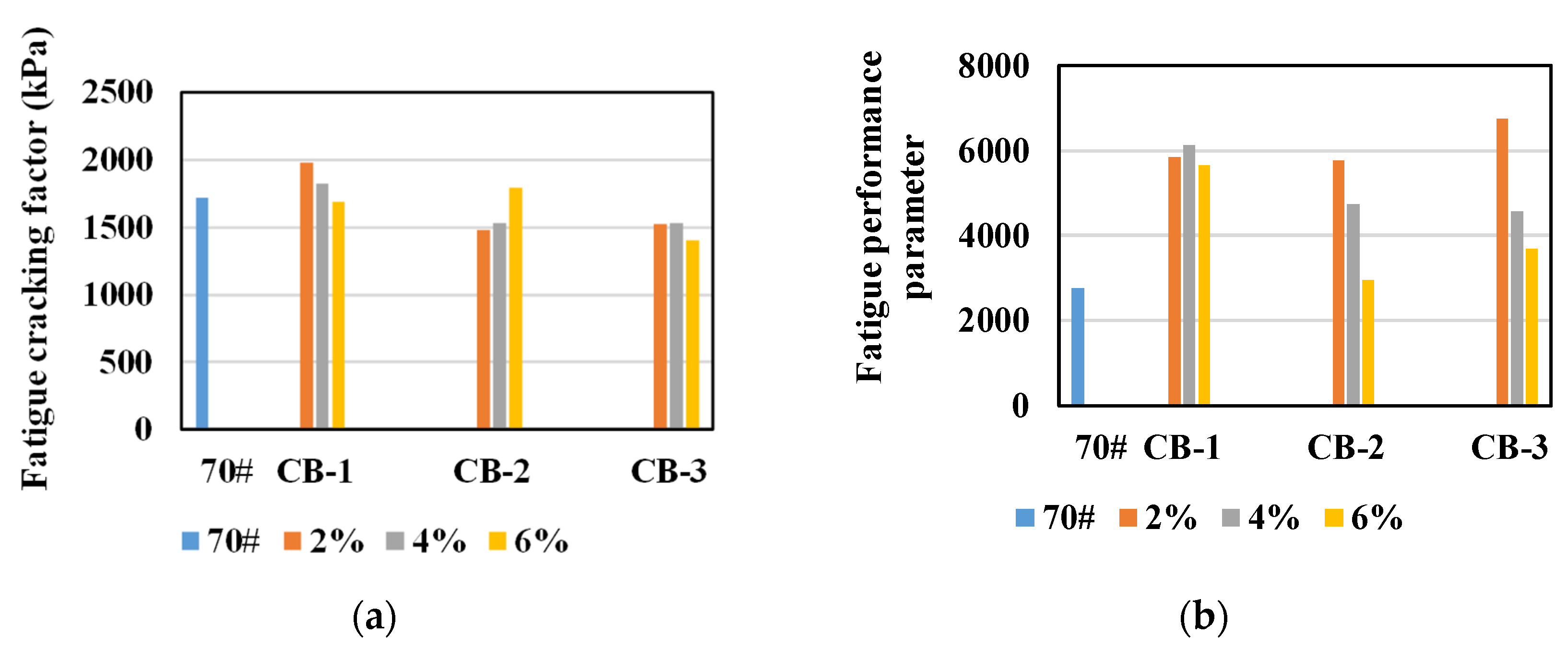

| Indicators | Unit | Values |
|---|---|---|
| Softening point | °C | 47.5 |
| Ductility | cm | 150 |
| Penetration | 0.1 mm | 64 |
| Flash point | °C | >260 |
| Density | g/cm3 | 1.034 |
Publisher’s Note: MDPI stays neutral with regard to jurisdictional claims in published maps and institutional affiliations. |
© 2021 by the authors. Licensee MDPI, Basel, Switzerland. This article is an open access article distributed under the terms and conditions of the Creative Commons Attribution (CC BY) license (https://creativecommons.org/licenses/by/4.0/).
Share and Cite
Zhong, K.; Li, Z.; Fan, J.; Xu, G.; Huang, X. Effect of Carbon Black on Rutting and Fatigue Performance of Asphalt. Materials 2021, 14, 2383. https://doi.org/10.3390/ma14092383
Zhong K, Li Z, Fan J, Xu G, Huang X. Effect of Carbon Black on Rutting and Fatigue Performance of Asphalt. Materials. 2021; 14(9):2383. https://doi.org/10.3390/ma14092383
Chicago/Turabian StyleZhong, Kunzhi, Zhi Li, Jianwei Fan, Guangji Xu, and Xiaoming Huang. 2021. "Effect of Carbon Black on Rutting and Fatigue Performance of Asphalt" Materials 14, no. 9: 2383. https://doi.org/10.3390/ma14092383
APA StyleZhong, K., Li, Z., Fan, J., Xu, G., & Huang, X. (2021). Effect of Carbon Black on Rutting and Fatigue Performance of Asphalt. Materials, 14(9), 2383. https://doi.org/10.3390/ma14092383








